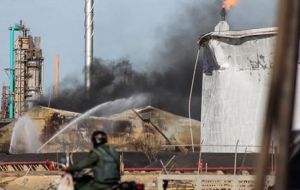MercoPress. South Atlantic News Agency
Venezuelan refinery ‘cooling down’; independent report points to serious lack of maintenance
 The aftermath of “the most lethal industry accident in Venezuela to date”
The aftermath of “the most lethal industry accident in Venezuela to date” Venezuela is carrying out an “exhaustive” inspection of its biggest refinery before attempting to restart processing after extinguishing a four-day fire yesterday caused by an explosion that killed 48 people and left hundreds homeless.
Although the government strongly denies it an independent March report from RJG Risk Engineering of London and circulated by CNN, points to a serious lack of maintenance at the Amuay refinery. The report also said 100 fires occurred in 2011 at the refinery complex.
State-owned Petroleos de Venezuela SA, PDVSA, is “in no hurry” to restart the Amuay refinery and will allow for at least a one-day cooling-down period, Oil Minister Rafael Ramirez told reporters in Falcon state near the plant.
PDVSA continues to export oil and petroleum products stored at Amuay’s dock and sees no disruption to its internal or external shipping obligations, Ramirez said.
“We’re carrying out a cooling process of all areas that suffered intense heat generated by the fire,” Ramirez said. “Because we are dispatching, because we have sufficient storage, because we have all our plants in perfect shape, we have no need to hurry to re-activate an operation.”
Production may restart in two to three days, Jesus Luongo, head of the Paraguana refining complex said on state television on Tuesday. Strong winds could cause the fires to reignite and if that happens firemen will use foam to extinguish them, he said.
Amuay, which has the capacity to process 645,000 barrels a day, is part of the Paraguana complex 380 km west of Caracas. While Ramirez described the situation as “chaos with fires everywhere” when he first arrived on the scene Aug. 25, he said damage was limited to 9 of 686 storage tanks.
Venezuela has stockpiles of 4.2 million barrels of gasoline and other petroleum products and continues to produce 735,000 barrels of the motor fuel a day at plants, including nearby Cardon, according to Ramirez. PDVSA shipped five tankers carrying 876,000 barrels of crude from Paraguana on Aug. 26, he said on Tuesday.
“This gives us 10 days of inventory,” Ramirez said. “On top of that, the inventory presupposes you aren’t producing anything. There’s no way we can have a problem’.
The fires at the Amuay refinery since Saturday have been described as “the most lethal industry accident in Venezuela to date” by analysts and come as the country faces other infrastructure problems, apparently because of a lack of maintenance, including a bridge collapse in Caracas, analysts said.
However in the aftermath of the fires, the government's refinery manager said the explosion wasn't due to a lack of maintenance, according to government television. Chavez has also said that such suggestions are “irresponsible” because investigators are still trying to determine the cause of the accident.
Earlier this year, an engineering firm's inspection of the giant Paraguana refinery complex in Falcon state, which includes the Amuay plant, found problems in major and routine maintenance, according to a March 2012 report prepared by RJG Risk Engineering of London.
The report also said 100 fires occurred in 2011 at the refinery complex, which includes the second refinery at Cardon.
The engineer firm's report was circulated on the Internet, and CNN confirmed its authenticity through a source which had a copy of the original.
“Overall, we see some positive progress, although we continue to rate this large refinery complex as 'in need of improvement' as in 2010,” the report said. “A stronger 'proactive' approach is necessary in our opinion.
”Major maintenance (turnarounds) has been seen to be suffering from delays, typically of one or two years,“ the report said.
”Routine maintenance suffered a significant 'low' in 2009, the effects of which are still being felt, evidenced by a marked increase in the ratio of corrective to preventive maintenance,” the study said.




Top Comments
Disclaimer & comment rules-

-

-

Read all comments“We’re carrying out a cooling process of all areas that suffered intense heat generated by the fire,” Ramirez said. “Because we are dispatching, because we have sufficient storage, because we have all our plants in perfect shape, we have no need to hurry to re-activate an operation.”
Aug 30th, 2012 - 04:42 am 0RIP 48 Innocent souls who sadly are also in no hurry. The curse of the black gold strikes again.
“Strong winds could cause the fires to reignite ” - Crikey - what sort of wind do they get in Venezuela? Ever heard of strong winds starting fires before?
Aug 30th, 2012 - 06:35 am 0What that really means is that the fires haven't been completely extinguished.
#2
Aug 30th, 2012 - 07:12 am 0Hi Idle hands,
Tank fires are put out with foam which eventually sits on the surface of the burning hydrocarbon blocking the oxygen supply to the fire, the oil and surrounding metal is still extremely hot for hours (given the volume), the wind can cause the foam creating the blanket to break up and expose the hot oil and reform the fire triangle and then re ignition. It's only the motion effect of the wind which is the problem until the mass cools below re-ignition temperatures, this is a common issue when dealing with tank farm fires and re ignitions are not uncommon. They could have explained it better in the article ;-)
Commenting for this story is now closed.
If you have a Facebook account, become a fan and comment on our Facebook Page!